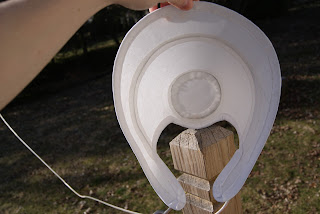Hi everyone,
I want to thank each and every one of my followers that I've gathered through the years. Your comments and questions have been wonderful to keep me inspired.
I wanted to make an announcement to you all, that after months of consideration I have decided to start a new blog on WordPress and no longer post on Music, Corsets, and Star Wars.
Those close to me know that I've had a lot of life changes in the last 7 months, and I felt it was fitting to start a new blog. I hope you all will continue to follow me on my new blog "Lady of the Wilderness"
Thank you!
The 3rd Annual Civil War Ball at the Athens County Historical Society and Museum
Saturday was the Athens County Historical Society and Museum's annual Civil War Ball and I had a great time! I didn't take a TON of pictures, but I took a few. This year I loaned my grey ball dress to my friend, Lizy, because she fits it in it perfectly. I wore my blue plaid ball dress with a bouquet/corsage and a flowery headpiece that I put together in a few hours before the ball (inevitably I leave it up to the last minute).
I based my headpiece to be similar to
And the headdress on the lady in yellow, below:
And here's what I ended up with!
Enjoy!
I based my headpiece to be similar to
| Headdress and Matching Bouquet- MidCentury French from The Museum of Fine Arts Boston |
| 1858 Petersons Magazine |
 |
| Right Side |
 |
| Left Side |
 |
| Back (With fake hair) |
 |
| The Ultimate 1860's Selfie |
 | |
| The dancefloor halfway through the night |
 |
| 'Twas a good night! |
An interview for me!
I was recently interviewed for a local Ohio University student blog called Beta Fish Magazine and wanted to share it with you!
Click here to read the interview!
Click here to read the interview!
An 1860's Bonnet: Part 2
If you didn't get a chance to read Part 1 of my bonnet adventures, click here!
So, to start where I left off, I had researched drawn bonnets for the 1860's and came across a lovely image of a great specimen.
From looking at the images, it seems that the canes are not relied upon for the shape of the bonnet. Typically there are two types of understructures, wire base and buckram base (sometimes a mix of the two). Wire bases are more for sheer bonnets or ones that don't require a lot of extra structure. Buckram bases are more sturdy and structured, and can be sewn directly into to keep fashion fabric in place. I inferred that the bonnet's understructure is a buckram base, which allows for the canes to be decorative. This explains the interesting pattern on the caul of the bonnet.
From this point, I decided to start working on the base. Getting the shape is the hardest part, since I've not made one before. I made little paper prototypes to get an idea of the pattern pieces. It took a lot of tries, but I figured out what shapes make what bonnets.
When I found the approximate shape I was looking for, I made real size paper prototype. This became the pattern.
Afterward, I cut out the pieces in buckram and found that it wasn't as sturdy as I was hoping. I fused two layers together to get the right thickness. As with most buckram bases, the ends need to be wired. So, (as I am cheap and always make these kinds of things spur of the moment) I lock-stitched (by hand) galvanized steel wire from Lowes to the edges instead of waiting for millinery wire, then covered the wire with white bias tape. It worked out pretty well, I think. But in the future I'd like to see if millinery wire makes any difference.
I ended up getting a great shape for my bonnet! I'm really pleased with the pattern.
So, to start where I left off, I had researched drawn bonnets for the 1860's and came across a lovely image of a great specimen.
From looking at the images, it seems that the canes are not relied upon for the shape of the bonnet. Typically there are two types of understructures, wire base and buckram base (sometimes a mix of the two). Wire bases are more for sheer bonnets or ones that don't require a lot of extra structure. Buckram bases are more sturdy and structured, and can be sewn directly into to keep fashion fabric in place. I inferred that the bonnet's understructure is a buckram base, which allows for the canes to be decorative. This explains the interesting pattern on the caul of the bonnet.
 |
| tiny bonnet! |
When I found the approximate shape I was looking for, I made real size paper prototype. This became the pattern.
 |
| paper and tape, that is all! |
I ended up getting a great shape for my bonnet! I'm really pleased with the pattern.
Subscribe to:
Comments (Atom)





